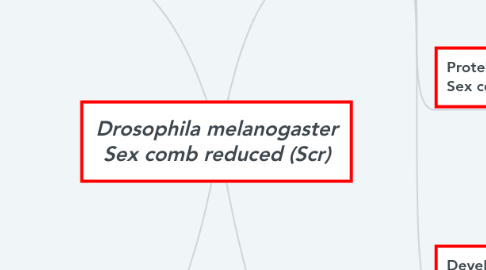
1. Question(s)
1.1. How could Scr gene expression affect sex comb morphology?
1.1.1. Bristle numbers?
1.1.2. Symmetry
1.1.3. Size
1.2. Could the manipulated sex comb morphology (result of Scr expression manipulation) have an effect on sexual selection?
1.2.1. male-male competition
1.2.2. female choice based on sex comb phenotype
1.2.3. variation of sex comb phenotype
1.2.3.1. increase
1.2.3.2. decrease
2. Methods
2.1. Introduce mutation(s) to Scr gene via vector
2.1.1. Use the five hypomorphic mutations described in earlier studies
2.1.1.1. Scr1
2.1.1.2. Scr3
2.1.1.3. Scr5
2.1.1.4. Scr6
2.1.1.5. Scr8
2.2. Or modify Scr protein expression via PTM at N-terminal homeodomain arm
2.2.1. Desphosphorylation
2.2.1.1. Active Scr
2.2.2. Phosphorylation
2.2.2.1. Inactive Scr
2.3. Measure Sex comb morphologies (bristle numbers, length, size, symmetry and shape
2.4. Plot mutations, sex comb morphologies and reproductive success of males and determine if correlations are statistically significant
3. Scr gene
3.1. Species: Drosophila melanogaster
3.2. Gene family: Homeobox (Hox) proteins
3.3. Tissue specificity gene expression :
3.3.1. Embryo: labial & anterior prothoracic segments & extreme posterior of the maxillary segment
3.3.1.1. Denticle belt formation and fusion of labial lobes
3.3.2. Adults: eye maxillary analgen, antennal imaginal disk, labial and T1 leg imaginal disks
3.4. Protein product: Homeotic protein Sex comb reduced (Scr)
3.4.1. Function: DNA binding transcription factor
3.4.2. Function: developmental protein
3.4.3. PTM: phosphoprotein (S216)
3.4.4. Length: 417 amino acids
3.4.5. Structure: Mostly helices, with an Antp-type hexapeptdie motif
3.4.6. Subtypes: RA, RD, RE, RF, RB
3.5. Development of salivary glands and sex comb dependent on Scr expression
4. Sex comb
4.1. Secondary, dimorphic sex organ
4.2. Morphology correlated with male reproductive success
4.2.1. bristle numbers
4.2.2. size
4.2.3. symmetry
4.2.4. absent/ present
